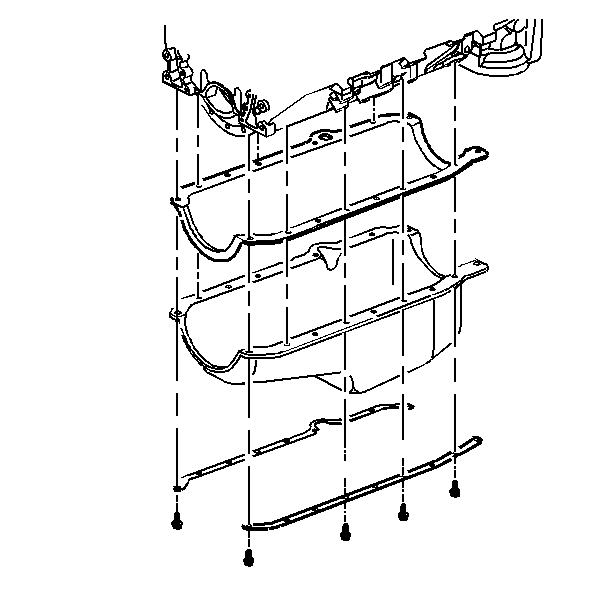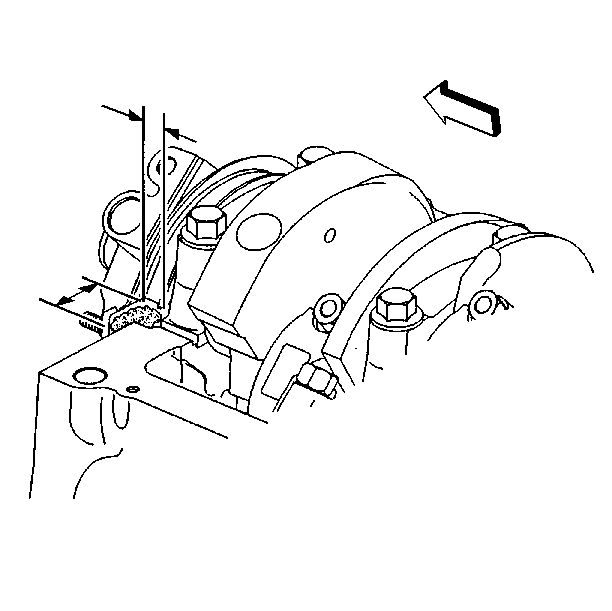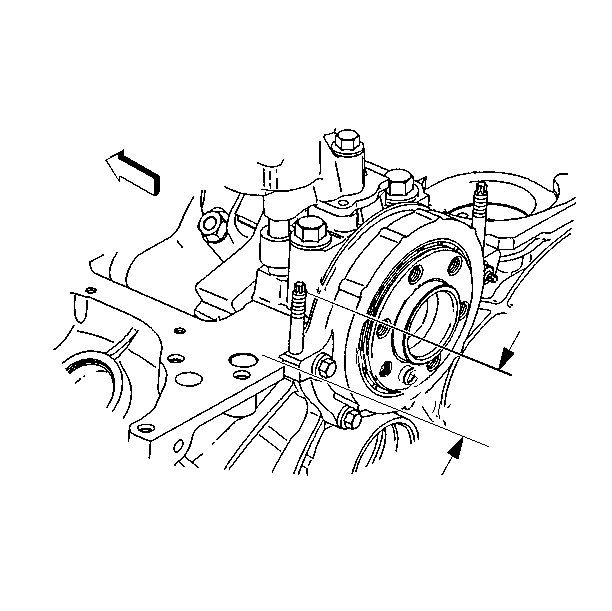Oil Pan Replacement C Models
Removal Procedure
A one-piece type oil pan gasket is used.
- Disconnect the battery negative cable assembly from the battery
negative terminal. Refer to
Caution: Unless directed otherwise, the ignition and start switch must be in the OFF or LOCK position, and all electrical loads must be OFF before servicing any electrical component. Disconnect the negative battery cable to prevent an electrical spark should a tool or equipment come in contact with an exposed electrical terminal. Failure to follow these precautions may result in personal injury and/or damage to the vehicle or its components.
in General Information. - Remove the oil level indicator.
- Raise the vehicle. Refer to General Information.
- Support the vehicle with safety stands.
- Drain the crankcase. Refer to Engine Oil and Engine Oil Filter Change in Maintenance and Lubrication.
- Remove the exhaust crossover pipe. Refer to Exhaust Pipe Replacement in Engine Exhaust.
- Remove the flywheel/torque converter inspection cover. Refer to Transmission.
- Remove the transmission oil cooler line retainer from the bracket, (automatic transmission only).
- Remove the oil filter.
- Remove the oil filter adapter from the lines. Tie the oil cooler lines out of the way. Refer to Oil Filter Adapter and Bypass Valve Replacement .
- Remove the oil pan bolts, nuts, and strut rods (if equipped).
- Remove the oil pan and gasket.
- Clean the gasket surfaces on the engine and oil pan.
- Inspect the oil pan gasket for damage. Replace if necessary.

Installation Procedure
- Apply sealant GM P/N 12346004 or the equivalent to the front cover to block joint. Apply the sealant for about 25 mm (1 in) in both directions from each of the four corners.
- Apply sealant GM P/N 12346004 or the equivalent to the rear crankshaft seal to block joint. Apply the sealant for about 25 mm (1 in) in both directions from each of the four corners.
- Install the oil pan gasket to the oil pan.
- Install the oil pan to the engine.
- Install the oil pan bolts, nuts, and strut rods (if equipped).
- Install the oil filter adapter. Refer to Oil Filter Adapter and Bypass Valve Replacement .
- Install the oil filter.
- Install the transmission oil cooler line retainer to the bracket (automatic transmission only).
- Install the flywheel/torque converter inspection cover. Refer to Transmission.
- Install the exhaust crossover pipe. Refer to Exhaust Pipe Replacement in Engine Exhaust.
- Remove the safety stands.
- Lower the vehicle.
- Install the oil level indicator.
- Connect the battery negative cable assembly to the battery negative terminal.
- Fill the engine crankcase with the proper quantity and grade of engine oil. Refer to Engine Oil and Engine Oil Filter Change in Maintenance and Lubrication.



Tighten
Tighten the oil pan bolts and nuts to 25 N·m (18 lb ft).
Notice: Use the correct fastener in the correct location. Replacement fasteners must be the correct part number for that application. Fasteners requiring replacement or fasteners requiring the use of thread locking compound or sealant are identified in the service procedure. Do not use paints, lubricants, or corrosion inhibitors on fasteners or fastener joint surfaces unless specified. These coatings affect fastener torque and joint clamping force and may damage the fastener. Use the correct tightening sequence and specifications when installing fasteners in order to avoid damage to parts and systems.
Tighten
Tighten the bolt to 15 N·m (11 lb ft).
Oil Pan Replacement K Models
Removal Procedure
- Disconnect the battery negative cable assembly from the battery
negative terminal. Refer to
Caution: Unless directed otherwise, the ignition and start switch must be in the OFF or LOCK position, and all electrical loads must be OFF before servicing any electrical component. Disconnect the negative battery cable to prevent an electrical spark should a tool or equipment come in contact with an exposed electrical terminal. Failure to follow these precautions may result in personal injury and/or damage to the vehicle or its components.
Battery Disconnect Cautionin General Information. - Remove the oil level indicator.
- Raise the vehicle. Refer to General Information.
- Support the vehicle with safety stands.
- Drain the crankcase. Refer to Engine Oil and Engine Oil Filter Change in Maintenance and Lubrication.
- Remove the underbody protection shields in order to gain access to the axle bolts. Refer to Steering Linkage.
- Remove the transmission oil cooler line retainer from the bracket (automatic transmission only).
- Remove the front propeller shaft at the front axle. Refer to Propeller Shaft Replacement in Propeller Shaft.
- Disconnect the front drive axle using the following procedure:
- Remove the exhaust crossover pipe. Refer to Exhaust Pipe Replacement in Engine Exhaust.
- Remove the flywheel/torque converter inspection cover. Refer to Transmission.
- Remove the oil filter and adapter. Refer to Oil Filter Adapter and Bypass Valve Replacement Oil Filter Adapter and Bypass Valve Replacement .
- Remove the oil cooler line retainer from the bracket (if equipped).
- Tie the oil cooler lines to the side.
- Remove the oil pan bolts, nuts, and strut rods, (if equipped).
- Remove the oil pan and gasket.
- Clean the gasket surfaces on the engine and oil pan.
- Inspect the oil pan gasket for damage. Replace if necessary.
| • | Remove two right side bolts and nuts. |
| • | Remove one left upper bolt and nut. |
| • | Rotate the front drive axle forward. |
| • | Turn the front wheels to the left, this will allow for extra clearance if needed. |

Installation Procedure
- Apply sealant GM P/N 12346004 or the equivalent to the front cover to block joint. Apply the sealant for about 25 mm (1 inch) in both directions from each of the four corners.
- Apply sealant GM P/N 12346004 or the equivalent to the rear crankshaft seal to block joint. Apply the sealant for about 25 mm (1 inch) in both directions from each of the four corners.
- Install the oil pan gasket to the oil pan.
- Install the oil pan to the engine.
- Install the oil pan bolts, nuts, and strut rods, (if equipped).
- Install the oil filter and adapter. Refer to Oil Filter Adapter and Bypass Valve Replacement Oil Filter Adapter and Bypass Valve Replacement .
- Install the oil cooler line retainer to bracket (if equipped).
- Install the flywheel/torque converter inspection cover. Refer to Transmission.
- Install the exhaust crossover pipe. Refer to Exhaust Pipe Replacement in Engine Exhaust.
- Install the transmission oil cooler line retainer to the bracket, (automatic transmission only).
- Install the front drive axle. Refer to Front Driving Axle.
- Install the front propeller shaft to front axle. Refer to Propeller Shaft Replacement in Propeller Shaft.
- Install the underbody shields. Refer to Steering Linkage.
- Remove the safety stands.
- Lower the vehicle.
- Install the oil level indicator.
- Connect the battery negative cable assembly to the battery negative terminal.
- Fill the engine crankcase with the proper quantity and grade of engine oil. Refer to Engine Oil and Engine Oil Filter Change in Maintenance and Lubrication.



Tighten
Tighten the oil pan bolts and nuts to 25 N·m (18 lb ft).
Notice: Use the correct fastener in the correct location. Replacement fasteners must be the correct part number for that application. Fasteners requiring replacement or fasteners requiring the use of thread locking compound or sealant are identified in the service procedure. Do not use paints, lubricants, or corrosion inhibitors on fasteners or fastener joint surfaces unless specified. These coatings affect fastener torque and joint clamping force and may damage the fastener. Use the correct tightening sequence and specifications when installing fasteners in order to avoid damage to parts and systems.
Tighten
Tighten the bolt to 15 N·m (11 lb ft).
